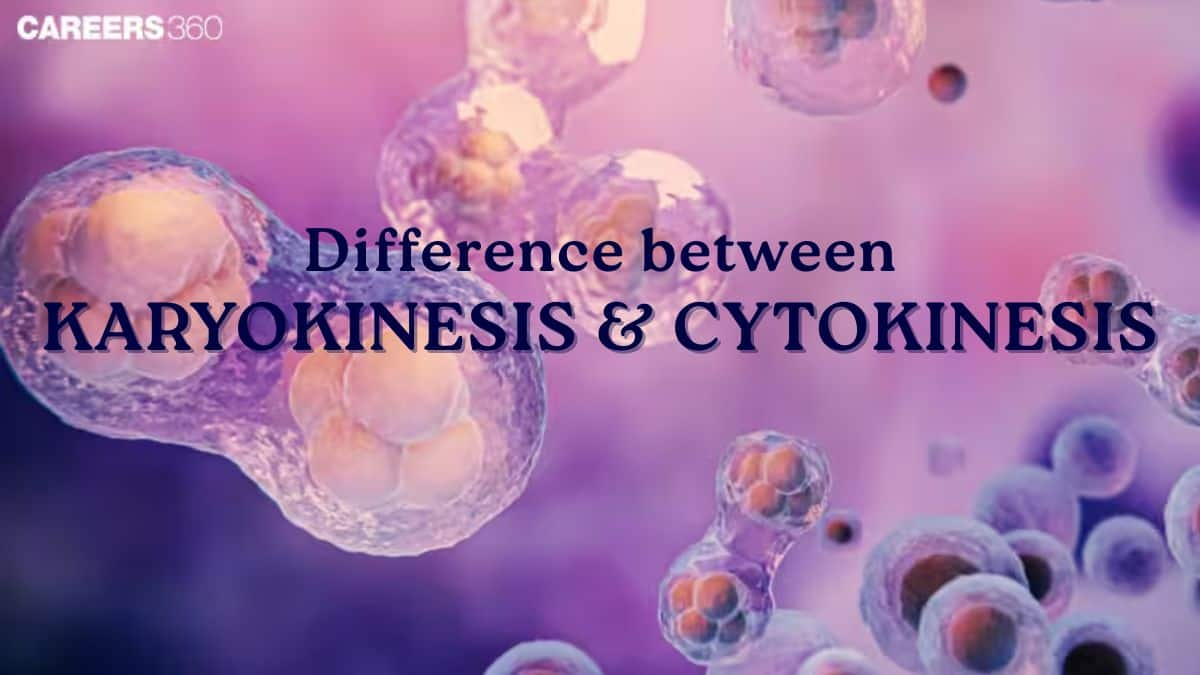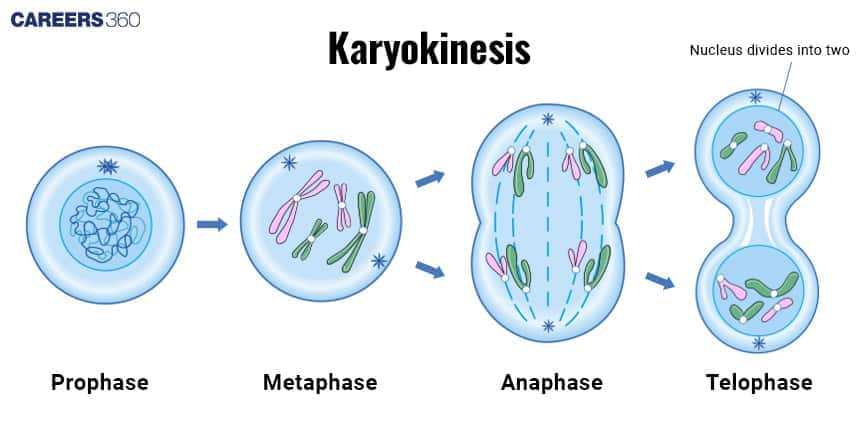Difference Between Karyokinesis And Cytokinesis: Overview, FAQs
Karyokinesis and cytokinesis are two key stages of cell division. Karyokinesis involves the division of the nucleus, while cytokinesis divides the cytoplasm, forming two daughter cells. Together, they ensure equal genetic and cellular content — vital for growth, repair, and reproduction.
This Story also Contains
- Introduction
- What is Karyokinesis?
- Significance of Karyokinesis
- What is Cytokinesis?
- Significance of Cytokinesis
- Differences between Karyokinesis and Cytokinesis
- Biological Significance of Karyokinesis and Cytokinesis
- Errors and Anomalies
- Karyokinesis vs Cytokinesis NEET MCQs (With Answers & Explanations)

Introduction
Cell division is a basic process by which the organism is continuously developed, grown, and repaired. There are two major types of cell division: mitosis and meiosis. Both processes involved in cell division hold a significant part in the life of organisms, which is a potent tool for growth, reproduction, and adaptation.
Overview of Cell Division
Cell division is a process in which a parent cell divides to produce two or more daughter cells. Separation occurs such that, at the same time, the latter inherits the genetic material brought from the division.
Mitosis is the process of cell division by which one cell, called the mother cell, becomes two daughter cells. It plays a very essential role in developing, growing, and repairing tissues in multi-celled organisms. Meiosis is defined as a special kind of cell division that reduces the number of chromosomes. It is the process by which one diploid cell gets differentiated into four genetically different haploid cells.
Role of Karyokinesis and Cytokinesis
In mitosis, karyokinesis which is the division of the nucleus guarantees that the two daughter cells have similar genetic material while cytokinesis which is the division of the cytoplasm of the cell splits the cellular contents to produce distinct cells. It creates new tissues and cells, repairs damaged ones and reproduces their kind, therefore making life and genetic reproduction go on in successive generations.
What is Karyokinesis?
Karyokinesis is a process through which a nucleus gets divided in the process of mitosis or meiosis to make two or more daughter nuclei.
Phases of Karyokinesis
Prophase
Chromosomes condense and can be observed with light microscopy. The nuclear envelope starts to disintegrate and spindle fibres develop.
Metaphase
Chromosomes align themselves in the middle of the developing cell wall, also called the metaphase plate. Spindle fibres connect to the kinetochores in the centromeres of every chromosome.
Anaphase
Sister chromatids begin to separate and move closer to the poles of the cell which is due to spindle fibers.
Telophase
Chromatids also get deposited to the poles and tend to decondense into chromatin. A new nuclear envelope is formed for each set of chromosomes.

Significance of Karyokinesis
The significance of karyokinesis includes:
Ensures Equal Genetic Distribution
Karyokinesis guarantees that every daughter cell gets a full set and an identical copy of the genetic information.
Role in Growth and Repair
It preserves the genetic continuity between generations of cells, the growth and repair, as well as the division and reproduction of multicellular organisms.
Maintenance of Chromosomal Stability
It ensures that the correct number of chromosomes are passed on to the next generation.
What is Cytokinesis?
Cytokinesis is the last phase of cell division that results in the formation of two daughter cells each having its nucleus, from a single parental cell.
Cytokinesis in Animal Cells (Cleavage Furrow Formation)
In animal cells, cytokinesis is distinguished by the formation of a cleavage furrow and this pinches the cell into two daughter cells.
Cytokinesis in Plant Cells (Cell Plate Formation)
The plant cells in the process of cytokinesis initiate a cell plate at the equator of the dividing cell that later on differentiates into a new cell wall, which is found separating the daughter cells.

Significance of Cytokinesis
The significance of cytokinesis includes:
Equal Division of Cytoplasm
Cytokinesis makes certain that equal numbers of organelles and genes are passed from the parent cell to each daughter cell for growth, tissue repair in multicellular organisms, and reproduction.
Formation of Functional Daughter Cells
Cytokinesis ensures the equal division of cytoplasm between two daughter cells, resulting in genetically identical and functionally independent cells.
Role in Tissue Repair and Regeneration
In mitosis, cytokinesis splits the parent cell into two daughter cells which are required for growth and repair. It also helps in the healing of wounds and renewal of body cells.
Differences between Karyokinesis and Cytokinesis
The following draws the comparison between karyokinesis and cytokinesis:
Aspect | Karyokinesis | Cytokinesis |
Definition and Process Comparison | Division of the nucleus during cell division. | Division of the cytoplasm and organelles to form two daughter cells. |
Timing within the Cell Cycle | Occurs during the M phase (mitosis or meiosis). | Follows immediately after karyokinesis, in the M phase. |
Mechanisms Involved | Involves processes like condensation of chromosomes, alignment at the metaphase plate, and separation of chromatids. | In animal cells, it involves the formation of a cleavage furrow by contractile ring proteins (actin and myosin). In plant cells, it involves the formation of a cell plate from Golgi-derived vesicles. |
Structural Changes in the Cell | Chromosomes condense and align during metaphase; the nuclear envelope breaks down during anaphase. | Cell membrane or cell wall invaginates or forms between the two nuclei, dividing the cytoplasm and organelles into two separate daughter cells. |
Biological Significance of Karyokinesis and Cytokinesis
The biological significance is discussed below:
Role in Growth and Development
Cytokinesis finalises the cell division to create two daughter cells that may further grow and develop tissues and/or organs.
Role in Tissue Repair and Regeneration
It aids in the renewal of our tissues because it is instrumental in the division of affected cells and the surmounting formation of new tissue layers.
Errors and Anomalies
The errors during cytokinesis and karyokinesis are discussed below:
Errors During Karyokinesis (Nondisjunction, Chromosomal Imbalance)
Nondisjunction is a phenomenon that takes place when chromosomes do not segregate in the right manner during cell division. This may cause the formation of an unequal ratio of chromosomes in daughter cells that leads to genetic diseases, for example, down syndrome in human beings.
Errors during Cytokinesis (Incomplete Division, Multinucleate Cells)
Cytokinesis failure occurs when the cytoplasm and or some of the organelles do not divide to the middle and segregate into the daughter cells. This can lead to the formation of multinucleate cells or cells of sizes that are not normal which affects their performance and may cause diseases such as cancer.
Consequences – Cancer and Tumor Formation
Mistakes that occur in a cell division can sometimes cause cellular death or cancer and tumour formation that grows in the organism.
Mutations and faults caused by the mistakes in the staking of cells can also influence the general well-being and physiological efficiency of organisms, they can grow, expand, and reproduce improperly.
Karyokinesis vs Cytokinesis NEET MCQs (With Answers & Explanations)
Important topics for NEET exam are:
Cytokinesis in plants and animals
Difference between karyokinesis and cytokineisis
Practice Questions for NEET
Q1. Failure of cytokinesis after telophase stage of cell division results in
Gain or loss of chromosomes in an organisms
An increase in a whole set of chromosomes in an organismAn increase in a whole set of chromosomes in an organism
Turner's syndrome
Aneuploidy
Correct answer: 2) An increase in a whole set of chromosomes in an organism
Explanation:
The failure of cytokinesis after the telophase stage of cell division results in an increase in the complete set of chromosomes within an organism. This phenomenon is called polyploidy. Polyploidy is significant in various biological processes, particularly in plant evolution and speciation, as it can enhance genetic diversity and adaptability.
Hence the correct answer is option 2) An increase in a whole set of chromosomes in an organism.
Q2. In a plant cell, cell plate formation is laid down during
Cytokinesis
Karyokinesis
Interphase
Anaphase
Correct answer: 1) Cytokinesis
Explanation:
In a plant cell, the cell plate emerges in the latter phase of the cell cycle, specifically during cytokinesis, which is the M phase's culmination following mitosis. Unlike animal cells, which utilize cleavage due to their flexible cellular structure, plant cells require the cell plate for cytoplasmic division as a result of their rigid cell wall. This structure is vital as it facilitates the even distribution of the cell wall and plasma membrane among the two daughter cells, thereby upholding their structural integrity and function.
Hence, the correct answer is option 1) Cytokinesis.
Q3. Interkinesis occurs
After cytokinesis I
After telophase I
After telophase of mitosis
None of these
Correct answer: 1) After cytokinesis I
Explanation:
Interkinesis, also known as intermeiotic interphase, is the short resting phase between Meiosis I and Meiosis II. Unlike the interphase of mitosis or meiosis I, no DNA replication occurs during interkinesis because the chromosomes are already duplicated. However, some cellular processes like protein synthesis and organelle reorganization take place to prepare for Meiosis II. The nuclear envelope may partially reform in some species, while in others, the chromosomes remain condensed. Interkinesis is generally brief and varies among different organisms. Once it ends, the cells proceed directly to Meiosis II, where sister chromatids separate, leading to the formation of four haploid gametes.
Hence the correct answer is option 1) After cytokinesis I
Also Read:
Frequently Asked Questions (FAQs)
When karyokinesis takes place without cytokinesis, the outcome is the formation of a multinucleate cell or when more than one nucleus is located in the same cytoplasmic area. This process, called syncytium, is possible in some tissues due to the cells’ development or at stages of certain diseases.
In animal cells, cytokinesis involves the formation of cleavage furrows around the existing equator that divide the cell into two daughter cells. On the other hand, the cytokinesis of plant cells involves a cell plate.
Some of the important functions of microtubules are – the apparatus that organises the chromosomes during the process of cell division. At anaphase, the microtubules start to retract and this helps in the separation of the two sister chromatids to the two poles of the cell.
Karyokinesis is followed by cytokinesis because cytokinesis draws the process of cell division to a close by splitting the two newly formed daughter cells. If cytokinesis does not occur, instead of one nucleus in one cell, multiple nuclei will be in a cell disrupting the cellular organisation and functionality.
Yes, mistakes in karyokinesis or cytokinesis can lead to cancer because cancerous cells split again and again. Any mishap at the microtubule level such as the chromosomal nondisjunction during karyokinesis can result in aneuploidy in the daughter cells.